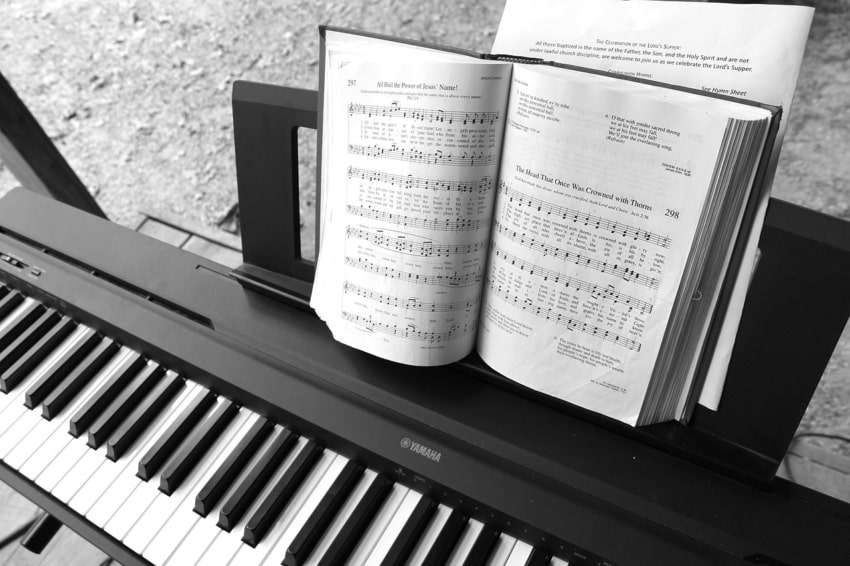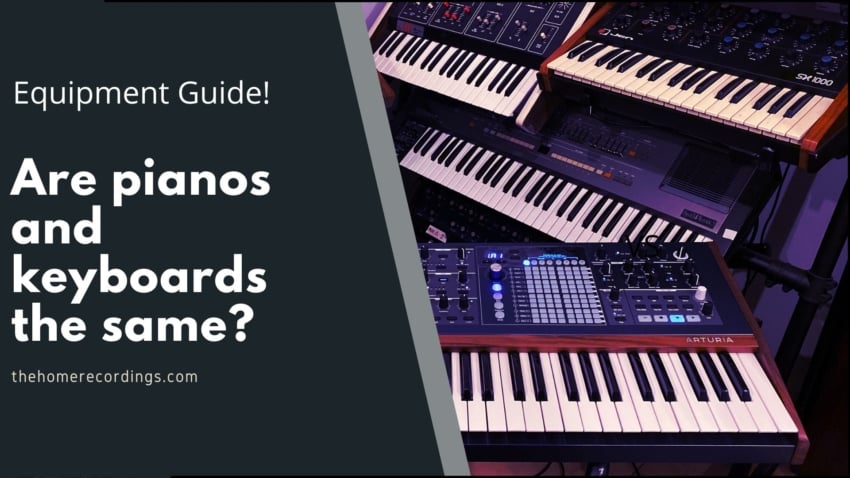Even though pianos and keyboard may appear to be the same thing, they are not, and this is something that might influence your decision on which one to buy since they serve different purposes.
In this article, I will be going over the differences between a piano and a keyboard as well as a MIDI controller, since it’s very similar to a Keyboard in a lot of ways
Are pianos and keyboards the same?
Pianos are acoustic instruments that produce sound when the steel strings inside of a hollow wooden body are struck by felt-tipped hammers, controlled by pressing the keys. Keyboards, on the other hand, are electronic emulations of pianos that don’t produce any sound naturally, but rather trigger pre-recorded sounds that are typically emitted through built-in speakers.
Of course, there a lot more that goes into it, so let’s keep going!
Keyboards With Weighted Keys (Difference between a Digital Piano and a Keyboard)

Many keyboards are crafted to have a feel and sound that as closely resembles an acoustic piano as possible – these are often called digital or e-pianos. One of the most important distinctions between a digital piano and other types of keyboards is the weighting of the keys.
The weight of a piano or keyboard’s keys can play an integral role in a pianist’s ability to play fluidly and control their dynamics. The keys of acoustic pianos are typically made of ivory or wood, and use a mechanical lever-type system that results in a distinct weight (or resistance) of the keys.
To give the player as realistic an experience as possible, digital piano manufacturers will custom adjust the weight of each (typically) plastic key so that when pressed, it responds similarly to that of an acoustic piano.
On the other hand, non-weighted keyboards often use a simple spring mechanism in each key to provide this resistance. While this certainly works in many situations, it can also make playing in a smooth and controlled manner much more difficult.
What about MIDI controllers?
A MIDI controller is a piece of hardware that generates and transmits Musical Instrument Digital Interface (MIDI) data to a computer. Some of this data includes which key is pressed, for how long, and with how much force (velocity).
Oftentimes, MIDI controllers are designed to imitate a keyboard, both in appearance and functionality. However, as I mentioned before, MIDI controllers don’t come with any built-in sounds and cannot produce sound by themselves.
Therefore, an external power and sound source is necessary for it to be usable. It’s worth noting that many MIDI controllers on the market these days do come with weighted keys and can be an effective substitute for a digital piano.
Primary Differences
Range
Very rarely will you find an acoustic piano that deviates from the standard 88-key configuration (with a low ‘A’ on the bottom and high ‘C’ on top). Digital pianos and keyboards, however, come in many different configurations, such as 25, 44, and 61 key setups.
Most keyboards with less than 88 keys will have octave-switching buttons that allow you to access all the octaves of the instrument.
However, it can be more difficult to play two-handed pieces of music with such limited range, and this should be an important consideration when choosing which is best for you.
Portability
Another reason you may reach for a keyboard instead of a piano or digital piano is pure convenience. Both acoustic and digital pianos typically come constructed with additional hardware that give the instrument its shape and look (built-in height/body, pedals, etc.)
This can be a great option for someone who doesn’t envision moving their instrument often. However, for the mobile musician that needs to transport their instrument between gigs and shows, the more physically compact keyboard might be a better option.
Keyboards often don’t contain much unnecessary additional hardware other than the keys themselves (with some built-in space for the electronics), so the overall weight and size make them a much more portable option.
Maintenance
Due to the fact that pianos create their sound acoustically, many variables can affect the exact nature of the sound that is produced. For this reason, regular maintenance such as tuning and key-balancing are required for the instrument to stay functioning at its optimal level.
Conversely, since keyboards and digital pianos are simply playing back recorded sounds that never vary, nearly no maintenance is required.
Versatility
Keyboards and digital pianos often come pre-loaded with many different sounds and instrument imitations (synths, strings, horns, etc.), making them a much more versatile choice than the piano.
Additionally, they will usually have the option to connect to a PC via MIDI technology, broadening your sonic possibilities to anything your computer can produce.
Price Differences
On the low end of the spectrum, MIDI keyboards will be your cheapest bet as far as something that can act like a keyboard. Due mainly to their much cheaper cost of production, new MIDI keyboards can start as low as $40.
Digital pianos can vary widely in price, with some costing upwards of $5,000. However, a solid digital keyboard will run you somewhere in the $600-$800 range.
Since acoustic pianos are significantly more complex to manufacture, they will also cost you the most. Used pianos will often start around $5,000, while a top-of-the-line concert grand can run upwards of $150,000.
Conclusion
It’s important to ask yourself what you’re ultimately looking for out of your piano or keyboard before making a purchase.
Do you want to be able to play Beethoven’s Sonatas that require all seven octaves and nimble finger technique? Or are you simply looking for a tool that can help you write and arrange your next big pop song?
Understanding exactly what you want out of your piano or keyboard is the most important thing to keep in mind to make sure you don’t under or overestimate your needs.
FAQs
- Is it better to learn piano or keyboard? All pianos are keyboards, but not all keyboards are pianos. Therefore, learning to play a piano or digital piano will set you up to play a keyboard, while the reverse may not always translate.
- Is keyboard easier than piano? While keyboards may be more accessible, most pianists will tell you that it’s easier to play a piano than it is a keyboard. For reasons such as key weight and construction material, there is really no substitute for a true acoustic piano.
- Can I use a MIDI controller as a keyboard? Of course! So long as you have an external power source that can also generate and playback the sound of a piano or digital piano using the transmitted MIDI information.
- Can I use a MIDI controller to learn piano? Surely, although it may be a bit more difficult to translate your newly developed skills over to a piano. The keys on MIDI controllers are often much smaller than those on a piano, so playing one will not as accurately represent the real thing.
